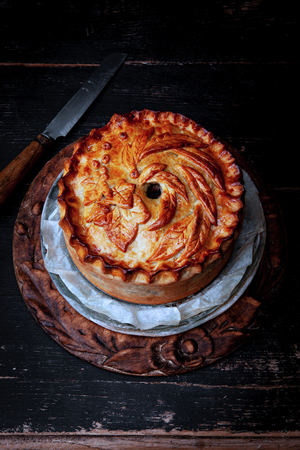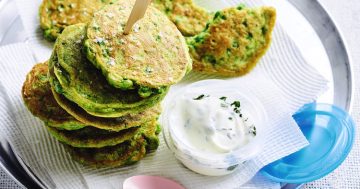By Christine Salins.
 In the foreword to Oats In The North, Wheat From The South (Murdoch Books, $49.99), food historian Dr Annie Gray writes about the difference between the “ethereal, sweet treats” of the French patisserie and English bakes that are “sturdy (and) packed with fruit, spice and flavour.”
In the foreword to Oats In The North, Wheat From The South (Murdoch Books, $49.99), food historian Dr Annie Gray writes about the difference between the “ethereal, sweet treats” of the French patisserie and English bakes that are “sturdy (and) packed with fruit, spice and flavour.”
“They don’t dance around your palate,” she says of the English bakes. “They grab you and hug you and tell you it’s all going to be all right.”
That sentiment strikes a chord in these crazy times of social distancing. I’m sure I’m not alone in spending more time cooking than I normally do. We’re not eating out and since we’ve chosen to isolate ourselves as much as possible, there’s more time to be creative in the kitchen.
Everyone needs hugs though, and if it means getting them from the warm embrace of home baking, then that’s the way it has to be.
As Dr Gray describes it, Oats In The North, Wheat From The South is a love letter to British baking. Interestingly, it was written (and photographed) by a Belgian woman, Regula Ysewijn, who not only has a particular interest in historical recipes and the evolution of food and drink, but also has an obsession with all things English.
It started in childhood and seemingly hasn’t waned, her parents encouraging her interest from the beginning. Family vacations were spent in Britain and always included a search for regional bakes and local bakeries. She loves the concept of afternoon tea and naturally there are recipes in the book for afternoon tea treats.
Apart from being a hugely talented photographer – the illustrations in the book are beautiful – Ysewijn has done an incredible amount of research. She shows how Britain’s diverse climate influenced the development of a rich regional baking identity. In the north, for example, oats and barley were more common than wheat because they could withstand the adverse weather.
She explains how imports of spices, sugar, treacle, fortified wines and citrus added flavour, colour and warmth, as in the Sweet Lamb Pie featured here. From a 1727 cookbook, it’s a good example of the old style of flavouring food using sweet, sour and savoury in harmony. It isn’t sweet but the spices used – nutmeg, mace and cloves – were once considered sweet spices. Dried fruits and candied peel add extra warmth.
Each of the recipes is accompanied by stories of the British landscape, legends and traditions, from Saffron cake, Cornish pasties, and Shrewsbury cake to tarts, oatcakes, gingerbreads, loaves, buns and bread rolls.
Ysewijn thinks the uniqueness of British baking has something to do with the fact that, unlike in France where pastries are usually bought in a patisserie, British people bake at home. “Scones taste best when they have just come out of the oven and are still steaming when you break them open. If you offer simple, modest bakes, you ensure the taste is 100 per cent spot on. You cannot hide behind cheerful colours and delicate frills.”
“British baking is cosiness and warmth,” she says, in what sounds like the perfect antidote for our present situation.
 Sweet Lamb Pie
Sweet Lamb Pie
Serves 4
For the hot water crust:
1 quantity Hot water crust pastry
For the pie:
400 g leg of lamb, deboned
1 tsp ground nutmeg
4 cloves, ground
¼ tsp ground mace
¹⁄8 tsp ground black pepper
300 g minced lamb neck
1 tbsp chopped parsley
50 g dried barberries and/or currants
300 g sweet potato, peeled and cooked, cut into 1 cm dice
150 g artichoke hearts, cooked, cut into 1 cm dice
10 g candied citrus peel, finely chopped
For the sauce:
juice of 1 lemon
the same amount of white wine
1 tsp sugar
1 egg yolk
1 tsp butter
For an 18 cm wide, 7 cm high springform cake tin or a 2 kg game pie mould
Cut the lamb into 2 cm chunks and dust with half of the spices. Add the other half of the spices to the minced meat and use your hands to mix the spices with the meat. Mix in the parsley and 2 tablespoons of the barberries or currants and roll the mixture into meatballs.
Preheat your oven to 200°C and line the base of the springform tin with baking paper.
Set aside a third of the pastry to make the lid (if possible, keep it warm). Roll out the remaining pastry until 8 mm thick. Place the pastry in the tin, mould it up the sides and make sure that there is some dough overhanging the edge to attach the pastry lid later. If you have cracks or holes, you can repair them with some left-over pastry.
Put some chunks of meat, meatballs, sweet potato and artichoke into the pastry crust and sprinkle some barberries or currants and candied peel over the top. Continue making layers of filling until the tin or mould is full. Roll out the pastry for the lid until 8 mm thick. Brush the edge of the crust with the egg wash and place the pastry lid on top. Cut away the excess pastry and crimp the edges together. Make a hole in the top for the steam to escape. Decorate the pie as desired with the excess pastry and egg wash.
Bake the pie in the middle of your oven for 30 minutes, then reduce the oven to 160°C and bake for another 1¾ hours.
When the pie is ready, make the sauce. Bring the lemon juice and wine to the boil with the sugar. Beat the egg yolk in a bowl and add the warm sauce as you would for a custard. Finish with a little butter and gently reheat. Pour the sauce through the hole in the top of the pie. Serve by cutting around the lid and slicing the pastry into wedges. Scoop out the filling and divide it among your guests.
From: Oats In The North, Wheat From The South by Regula Ysewijn, published by Murdoch Books, $49.99.



